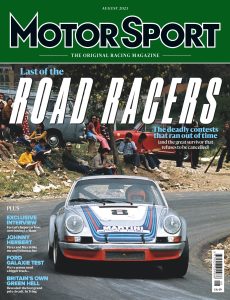
Motor Sport Magazine – August 2023
English | 174 pages | pdf | 98.47 MB
Welcome at Motor Sport Magazine August 2023 issue
We report this month on a new film telling the remarkable story of Nigel Mansell. The documentary was due to be shown on Sky on the weekend of the British Grand Prix – a fitting slot for a driver who, despite being a character who has always divided opinion, was in his pomp one of the biggest sports stars this country had ever produced. As Sir Patrick Head tells us in our new podcast series (available to listen via our website!) he is one of the most underrated drivers of the recent past.
The film, called Mansell and Williams: Red 5, is the latest in a line of ‘authorised’ documentaries. In other words it is made with the blessing of the subject and as such does not include critical voices. Other recent offerings include Lucky!, the eight-part series based on interviews with Bernie Ecclestone and made by Senna writer Manish Pandey, which offers a wonderful insight into the history of the controversial entrepreneur’s involvement in F1.
Then there was Mosley: It’s complicated, a biopic of Max released just months before the subject’s death and with his full support, exploring what drove one of the most influential men in the history of our sport. More even-handed – despite being a family affair that was directed by the subject’s son – was Stewart, telling the story of Sir Jackie’s ongoing career, complete with brilliant archive footage from that most evocative age of 1970s racing.
Perhaps the most affecting was the Villeneuve and Pironi documentary, released earlier this year. Although somewhat uninspringly titled The Untold Story, it nonetheless offered fresh family perspectives from both sides on that tragic rivalry. You could argue that we are living through a golden period of documentaries offering fascinating insight into motor racing with a style and sophistication that would have been unheard of a generation ago.
Of course, we must remember that these films are not journalism – they do not ask awkward questions or even set out opposing views for balance. Indeed, if the job of a journalist is to be defined, as someone once did, as revealing something that someone, somewhere doesn’t want revealed, then these films are actually the opposite of journalism. They are showing things that the people in focus most definitely do want to be shown and the line between journalism and public relations is well and truly crossed.
The most egregious example of this may well be the Netflix documentary Drive to Survive which despite its huge popularity has been accused not only of being public relations but of actually inventing drama where there is none in order to sex up the storytelling. Perhaps there is more to come with the news that the Alpine F1 team has sold a stake to a conglomerate including Hollywood actors Ryan Reynolds and Rob McElhenney. The pair have previously invested in Wrexham football club and documented its subsequent rise under their ownership for a Disney-Plus docuseries. Perhaps the change is indicative of a wider drift away from the idea of objective truth.
We used to assume that you only got the true story by a dispassionate observer or filmmaker interviewing all parties, but today the perspective has changed from the outsider looking in to the insider looking out. Nonetheless there is a value in these documentaries. Much like an authorised biography, they offer a viewpoint that while not free of bias still contributes to our understanding of how history unfolded. And in any case our knowledgeable readers will no doubt spot the cover-ups and pulled punches, leaving them free to enjoy the undeniably brilliant racing footage and interviews these documentaries include.
And if they are unsure as to what is real and what is embellished they can always check their facts in the pages of Motor Sport magazine (and via our online archive).
Staying with film, we are set for a bumper year of racing-themed releases, with plans for the long-awaited biopic of Enzo Ferrari, starring Adam Driver and directed by Michael Mann, due to hit the big screen in the autumn. Meanwhile filming of a new F1 movie starring Brad Pitt and co-produced by Lewis Hamilton is due to take place at the British GP. In the weeks leading up to that race the Silverstone track played host to numerous camera cars and production units as the film crew geared up for the race weekend where they would join the real drivers and cars during the GP for added verité.
This has caused much excitement among race fans. But film crews joining races has a long history, most famously during the 1970 Le Mans for Steve McQueen’s rather
indulgent epic released the following year. But it goes further back than that. Who can remember the 1929 film Speedway? A drama about a father and son who are both racing in the Indy 500. Much of the film was shot at that year’s race, courtesy of 14 cameras, including an on-track camera truck.
And before that even, way back in 1913 there was Fatty Arbuckle’s The Speed Kings – an eight-minute silent comedy set at a race track and featuring real life racers Earl Cooper and Teddy Tetzlaff as well as footage of actual races. Brad Pitt eat your heart out.
Download from: